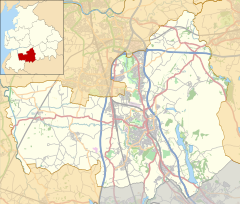
Gisborough Priory is a ruined Augustinian priory in Guisborough in the current borough of Redcar and Cleveland, North Yorkshire, England. It was founded in 1119 as the Priory of St Mary by the Norman feudal magnate Robert de Brus, also an ancestor of the Scottish king, Robert the Bruce. It became one of the richest monastic foundations in England with grants from the crown and bequests from de Brus, other nobles and gentry and local people of more modest means. Much of the Romanesque Norman priory was destroyed in a fire in 1289. It was rebuilt in the Gothic style on a grander scale over the following century. Its remains are regarded as among the finest surviving examples of early Gothic architecture in England.
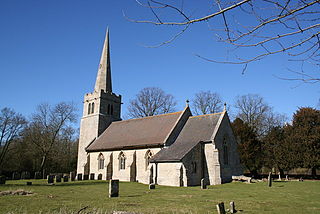
Ashby de la Launde is a small village, part of the civil parish of Ashby de la Launde and Bloxholm, in the North Kesteven district of Lincolnshire, England. The village is situated just west of Digby, and east of the A15 and B1191 roads. In 1921 the parish had a population of 200.
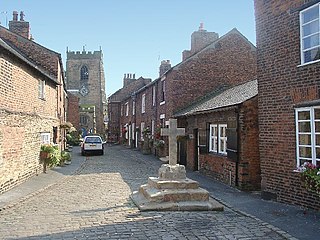
Croston is a village and civil parish near Chorley in Lancashire, England. The River Yarrow flows through the village. The population of the civil parish taken at the 2011 census was 2,917.

Dunham Massey is a civil parish in the Metropolitan Borough of Trafford, Greater Manchester, England. The parish includes the villages of Sinderland Green, Dunham Woodhouses and Dunham Town, along with Dunham Massey Hall and Park, formerly the home of the last Earl of Stamford and owned by the National Trust since 1976. Dunham Massey is in the historic county of Cheshire, but since 1974 has been part of Trafford Metropolitan Borough; the nearest town is Altrincham. At the 2001 census, the parish had a population of 475.

Bowdon is a suburb of Altrincham and electoral ward in the Metropolitan Borough of Trafford, Greater Manchester, England.

Bretherton is a small village and civil parish in the Borough of Chorley, Lancashire, England, situated to the south west of Leyland and east of Tarleton. The population of the civil parish at the 2011 census was 669. Its name suggests pre-conquest origins and its early history was closely involved with the manor house Bank Hall and the families who lived there. Bretherton remained a rural community and today is largely residential with residents commuting to nearby towns.

Cusworth Hall is an 18th-century Grade I listed country house in Cusworth, near Doncaster, South Yorkshire in the north of England. Set in the landscaped parklands of Cusworth Park, Cusworth Hall is a good example of a Georgian country house. It is now a country house museum.

Culcheth and Glazebury is a civil parish in Borough of Warrington, Cheshire, England. At the 2001 census, it had a population of 8,534.

South Wraxall Manor is a Grade I listed country house which dates from the early 15th century, at South Wraxall in the English county of Wiltshire, about 3 miles (5 km) north of Bradford on Avon. According to popular legend, the house was the first place tobacco was smoked in England, by Sir Walter Long and his friend Sir Walter Raleigh.

The de Trafford Baronetcy, of Trafford Park in the County Palatine of Lancaster is a title in the Baronetage of the United Kingdom.

Sir Thomas Joseph de Trafford, 1st Baronet, was a member of a prominent family of English Roman Catholics. He served as commander of the Manchester and Salford Yeomanry at the time of the Peterloo Massacre. He was born at Croston Hall near Chorley, Lancashire, on 22 March 1778, son of John Trafford and Elizabeth Tempest, and was christened Thomas Joseph Trafford.
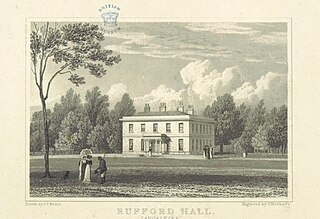
Rufford New Hall is a former country house that belonged to the Heskeths who were lords of the manor of Rufford, Lancashire, England. It replaced Rufford Old Hall as their residence in 1760. From 1920 to 1987 it was used as a hospital and has subsequently been restored and converted for residential use. It was designated a Grade II listed building in 1986.

Forde Abbey is a privately owned former Cistercian monastery in Dorset, England, with a postal address in Chard, Somerset. The house and gardens are run as a tourist attraction while the 1,600-acre (650 ha) estate is farmed to provide additional revenue. Forde Abbey is a Grade I listed building.

Preston Manor is the former manor house of the ancient Sussex village of Preston, now part of the coastal city of Brighton and Hove, England. The present building dates mostly from 1738, when Lord of the manor Thomas Western rebuilt the original 13th-century structure, and 1905 when Charles Stanley Peach's renovation and enlargement gave the house its current appearance. The manor house passed through several owners, including the Stanfords—reputedly the richest family in Sussex—after several centuries of ownership by the Diocese of Chichester and a period in which it was Crown property.

Trafford Hall is an 18th-century country house standing to the east of the village of Wimbolds Trafford in Cheshire, England, about 4+1⁄2 miles (7 km) northeast of the city of Chester. It is owned by The Regenda Group and operated as a youth hostel and training centre by the Youth Hostels Association.
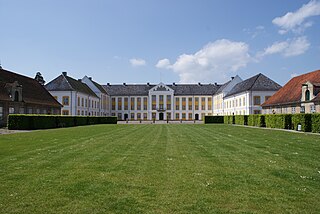
Augustenborg Palace is a Rococo-style palace in the southwestern part of Augustenborg, Als Island, Denmark, overlooking Augustenborg Fjord. The palace owes its name to Duchess Auguste (1633–1701). Augustenborg gave its name to the House of Schleswig-Holstein-Sonderburg-Augustenburg, the last member of which was Duke Christian August II (1798–1869).

The Palmes family of Naburn Hall, and the cadet branches of Lindley Hall, North Yorkshire; Ashwell, Rutland; and Carcraig in Ireland, are an ancient English aristocratic family, noted for their adherence to Catholicism.

Appleby Hall was a manor house or stately home built in the small hamlet of Appleby Parva, on the outskirts of Appleby Magna.

Thomas Norris FRAS was an English businessman, art collector, natural historian and astronomer, born at Croston in Lancashire. Joining the Bury firm of Peel, Yates and Co. as a book-keeper at the age of twenty, he eventually became a partner and amassed a considerable fortune from its success in the textile and calico-printing businesses. Amongst his partners at the firm was the businessman and politician Sir Robert Peel, whose son, also named Sir Robert Peel, served twice as Prime Minister of the United Kingdom. Norris was reputedly a regular and welcome visitor at the latter's home in Whitehall Gardens.
Walton Hall was a 17th-century historic country house, set in a 300-acre (1.2 km2) estate, which was demolished in the early 20th century. Sometimes referred to as Walton Old Hall, it was situated at the centre of the Walton Hall Park in Walton, Liverpool. Its former residents were Liverpool merchants and the last two families to reside at Walton Hall profited from the Atlantic slave trade. In the 19th century it was the home of Thomas Leyland during his second and third term as Lord Mayor of Liverpool.
